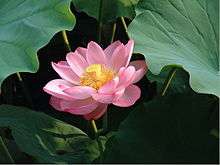Suchindram Theroor Birds Sanctuary
The Suchindram Theroor Birds Sanctuary is a protected area comprising the Suchindram Kulam wetlands at 8°7′30″N 77°27′30″E / 8.12500°N 77.45833°E, and the Theroor Kulam wetlands at 8°10′45″N 77°27′45″E / 8.17917°N 77.46250°E, both near Suchindram town in Kanyakumari District, Tamil Nadu state, South India. It is located between Nagercoil and Kanyakumari on the National Highway No. 47. Being at the extreme southern tip of India, this area underlies the southernmost continental range of the Central Asian Flyway. Constitution of this new wildlife sanctuary was proposed in 2002 and remains under consideration of the Government.[1][2] International name is Suchindram Therur, Vembanoor, Important bird area code no. IN279, criteria: A1, A4i.[3]
District of Ponds
About two thirds of the total area of Kanyakumari District is lowland plains dotted with 2,058 freshwater wetlands known as kulam or ponds. It is referred to as the District of Ponds. In addition to Suchindram-Theroor, other major freshwater wetlands of this district include Parakkai, Manikaputheri, Thathiar, Vembanoor, Chungankadai, Putheri, Thazhaikudi and Manavalkurchi.[4]
Kanyakumari Wildlife Sanctuary, a tiger habitat at the extreme southern end of the Western Ghats, is also in this district.
Flora

Suchindram pond has a large variety of aquatic vegetation including water lilly, lotus, floating hearts, pistia and other water plants. A few tall trees and other bushes have formed an island at the centre, which gives refuge and is a resting place for birds.[4]
Fauna

Suchindram is noted for the wide variety of migratory waterbirds that winter there, including: near threatened painted stork and spot-billed pelicans. Also seen here are cattle egrets, great cormorants, darters, purple swamphen, and bronze-winged jacanas. Resident raptors include pied kingfisher, brahminy kite and marsh harrier. Other water birds are dabchick, grey heron, garganey,[5] purple heron, cinnamon bittern, open bill stork, cotton pygmy goose, whiskered tern and little tern, black-winged stilt, greenshank, little ringed plover and the common sandpiper [4]
Conservation
In 1993, Dr. Robert Grubh, of Institute for Restoration of Natural Environment in Nagercoil, lead a program for Conservation and Management of Suchindram Kulam Wetland in Southern India for Promotion of Agriculture, Fishing and Ecotourism, in cooperation with the Conservation Impact Grants Program of a consortium of the World Wildlife Fund, The Nature Conservancy, and the World Resources Institute and funded by the United States Agency for International Development.[6]
Some local fisherfolk and agriculturists were not happy that a project was being developed to create a bird sanctuary at the Suchindram wetlands. They were concerned that sanctuary authorities would restrain fishing activities and more birds would destroy their crops. However, a large number of local people were engaged in wetlands conservation through the projects use of local television, field demonstrations, press interviews, and community lectures to stimulate conservation awareness. The Tamil Nadu Forest Department, District Collectors, the Public Works Department, village Panchayats and others have supported the conservation efforts.[7]
References
- ↑ "Policy Note on Forest and Environment 2002–2003, Demand No. 14". Government of Tamil Nadu. July 7, 2003. Archived from the original on 2003-11-25. Retrieved 2010-11-02.
- ↑ "11 more wildlife, bird sanctuaries". The Hindu. Apr 30, 2002. Retrieved 2009-01-08.
- ↑ BirdLife International Suchindram Therur, Vembanoor
- 1 2 3 GRUBH, SHAILAJA ROBERT (2003-02-01). "Sanctuary in the lowland plains". The Hindu. Retrieved 2009-01-08.
- ↑ "Garganey Anas querquedula". BirdLife Species Factsheet (additional data). BirdLife International. 2008. Archived from the original on December 1, 2008. Retrieved 2009-01-12.
- ↑ Grubh,, Dr. Robert. "India 1993". Conservation Impact Grants Program. Worldwildlife.org. Retrieved 2010-11-02.
- ↑ Division of International Conservation (November 20, 2008). "Conservation and Restoration of Biodiversity of the Tropical Freshwater Wetlands of Kanyakumari Plains in Peninsular India.". Tropical Freshwater Wetlands of India. U.S. Fish and Wildlife Service. Retrieved 2009-01-08.